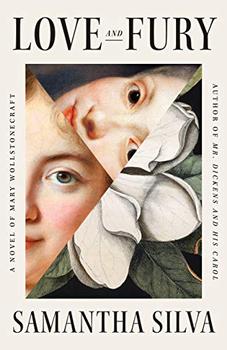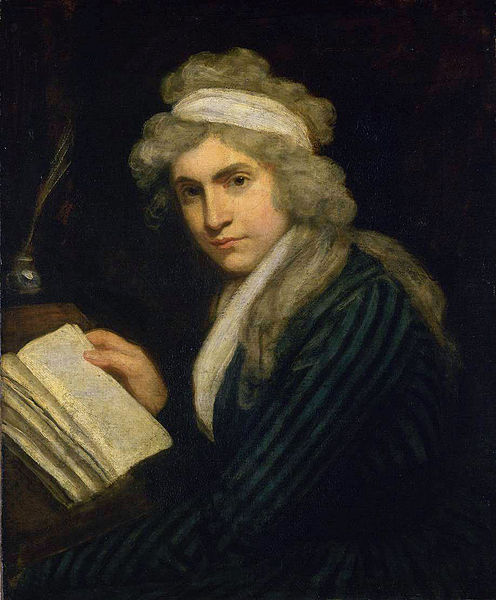Summary | Excerpt | Reading Guide | Reviews | Beyond the Book | Read-Alikes | Genres & Themes | Author Bio

A Novel of Mary Wollstonecraft
by Samantha SilvaThis article relates to Love and Fury
 Although the word "feminist" did not enter popular political discourse until over a century after her death, the published works of Mary Wollstonecraft show her to be one of the world's pioneering feminist writers. As Love and Fury explores in some detail, the events of Wollstonecraft's life were crucial in cementing her ideologies and philosophies concerning the roles and education of women. Her earliest gestures in defense of women included protecting her mother from her father's abuse and convincing her sister to leave her husband. However, the legacy of Wollstonecraft has been a rocky one. For a hundred years, society looked back on her life with harshness and skepticism, due in part to how she was portrayed by her spouse, William Godwin.
Although the word "feminist" did not enter popular political discourse until over a century after her death, the published works of Mary Wollstonecraft show her to be one of the world's pioneering feminist writers. As Love and Fury explores in some detail, the events of Wollstonecraft's life were crucial in cementing her ideologies and philosophies concerning the roles and education of women. Her earliest gestures in defense of women included protecting her mother from her father's abuse and convincing her sister to leave her husband. However, the legacy of Wollstonecraft has been a rocky one. For a hundred years, society looked back on her life with harshness and skepticism, due in part to how she was portrayed by her spouse, William Godwin.
After Wollstonecraft's death, Godwin wrote Memoirs of the Author of A Vindication of the Rights of Woman. This book reveals, with frankness and clarity, the most intimate details of his wife's life, including her love affairs, suicide attempts and illegitimate children. While Godwin reportedly claimed that he wrote about Wollstonecraft "with love, compassion and sincerity," this was not how the memoirs were received. And so, for the entirety of the 19th century, Wollstonecraft's legacy was largely defined by her personal life, which was viewed as scandalous.
It was the rise of women's suffrage in the early 20th century that reignited and reframed Wollstonecraft in the public eye. In 1929, author Virginia Woolf declared, "she is alive and active, she argues and experiments, we hear her voice and trace her influence even now among the living." This statement arguably showed not only the impact of Wollstonecraft's writing on other feminist writers, but also an acceptance of her actions while alive. In the 1960s, as feminism became more mainstream in academic circles, scholars of the subject turned their attention to the pioneering works of Wollstonecraft. She was now being studied and discussed, inspiring thinkers and writers more than 150 years after her death.
Today, the life and work of Wollstonecraft continue to influence the thoughts and work of modern scholars and writers. Her legacy shows no signs of slowing down, as the waves of feminism continue to rise and gain power across the globe.
Discussions around Wollstonecraft were relit in a surprising way in 2020 when Maggi Hambling's sculpture dedicated to the feminist icon was unveiled in Newington Green, North London. The sculpture, which presents "the naked everywoman emerging from a swirl of female forms," sparked an immediate and loud discussion amongst critics, academics and ordinary passers-by.
Lizzy Bassham, owner of a cafe in Newington Green, remarked that, "Opinions might be polarised, but everybody is talking about Mary, people are discussing it while they are getting a coffee. Mary Wollstonecraft was a radical woman and I think she would have loved the stir it has caused." Thanks to this sculpture, Wollstonecraft remains a source of conversation even in the 2020s.
Portrait of Mary Wollstonecraft (circa 1790-91) by John Opie (1761–1807), via Wikimedia Commons
Filed under Books and Authors
![]() This "beyond the book article" relates to Love and Fury. It originally ran in July 2021 and has been updated for the
May 2022 paperback edition.
Go to magazine.
This "beyond the book article" relates to Love and Fury. It originally ran in July 2021 and has been updated for the
May 2022 paperback edition.
Go to magazine.
He has only half learned the art of reading who has not added to it the more refined art of skipping and skimming
Click Here to find out who said this, as well as discovering other famous literary quotes!
Your guide toexceptional books
BookBrowse seeks out and recommends the best in contemporary fiction and nonfiction—books that not only engage and entertain but also deepen our understanding of ourselves and the world around us.